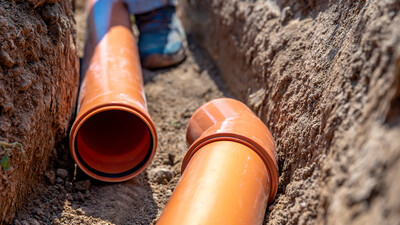Pipes perform a vital function across various industries by transporting liquid from one location to another. Different types of underground drainage pipes offer a range of features and are suited to specific applications. In this blog post, we will explore the different types of underground drainage pipes, examining their material and design, the functions they perform and their ideal application settings. This way, you can approach your drainage project with confidence and peace of mind.
Underground drainage pipes
Underground drainage pipe systems utilise various types of pipes for a wide range of drainage applications. uPVC (Unplasticised Polyvinyl Chloride) drainage pipes are durable for everything from large domestic projects to commercial developments. They are designed to handle large volumes of wastewater and effluent, maintaining efficient drainage flow and reducing the risk of blockages or backups.
The durable yet lightweight structure of uPVC drainage pipes makes installation straightforward while ensuring effective flow rates. It is also suitable for high-temperature waste discharge, allowing it to be used in systems where hot water or industrial effluent needs to be transported safely without damaging the pipework.
Socket bends
Drainage pipes guide wastewater efficiently due to socket bends that allow pipes to bend at specific angles, allowing them to flow around obstacles. They create a smoother flow path without causing blockages.
Inspection chamber bases and risers
Another key part of effective water drainage is preventing blockages. Inspection chambers and risers play an important role in this. Inspection chambers offer easy access to underground drainage pipes for monitoring and cleaning. Risers extend the chamber to ground level, making maintenance more straightforward and accessible.
Underground drainage pipes - sewer pipes
Underground drainage pipes handle wastewater and sewage from multiple buildings. They’re made from uPVC, polypropylene and polyethylene. Choosing the ideal underground drainage pipe for sewage will depend on the required use. Each material offers specific benefits, so selecting the right one ensures long-lasting performance, easy installation and effective sewage and wastewater management.
Types of underground sewer pipes
Adoptable sewer pipes
Adoptable sewer pipes meet industry regulations set by the Design and Construction Guidance (DCG) for water drainage systems. They’re made from polypropylene and feature a twinwall design that provides added durability while allowing liquids to flow efficiently. They’re available in 150mm, 225mm and 300mm diameters to suit a variety of ground drainage applications.
Standard sewer pipes
Standard sewer pipes are made from durable materials including uPVC, polypropylene and polyethylene. The different materials accommodate various commercial and industrial sewage systems, providing flexibility, strength and longevity for every project.
Surface water
It’s important to transfer surface water to prevent it from pooling and eroding soil, as well as to maintain proper conditions. When it comes to transferring surface water, twinwall drainage pipes offer a durable solution since they are made from High-Density Polyethylene (HDPE), making them lightweight, easy to handle and long-lasting. This allows for quick, efficient and effective installation. Common applications for surface water drainage pipes include sports fields, golf courses, footpaths and open fields. Their design enhances water flow, which is beneficial for managing water in large open areas.
Twinwall pipes
Standard twinwall pipes feature a smooth inner surface that allows water and waste to flow through with ease and reduces the chance of blockages occurring in a drainage system. Its lightweight design makes it easier to transport, handle and install. These pipes are also robust and long-lasting, making them ideal for a wide range of applications.
Ground drainage
Twinwall perforated pipes are designed with multiple holes to collect groundwater more efficiently in open areas susceptible to flooding and pooling. They regulate excess water without causing erosion and are versatile for various landscapes. They’re made from durable materials which are long-lasting and functional for various environments.
Twinwall perforated drainage pipes
Perforated pipes, commonly used in French drain systems, feature small holes or slots along their length. These openings allow groundwater to enter the pipe, which is then directed to a discharge point such as a soakaway, ditch or surface drain. This helps prevent waterlogging, flooding and pooling in areas with poor natural drainage. Perforated land drainage pipes are available in 150mm, 225mm, 300mm, 375mm, 450mm and 600mm sizes.
Underground sewer pipes
Plastic sewer pipes are an excellent choice for managing surface water and sewage drainage systems. Their durable design allows them to withstand ground pressure, chemical exposure and high water flow. They come in 200mm, 250mm and 315mm diameters, ideal for medium to large-capacity drainage systems.
Water pipes
Made from Medium-Density Polyethylene (MDPE), water pipes provide efficient transport of potable water from treatment plants to homes and businesses.
HDPE water pipes
HDPE water pipes are sturdy, lightweight and resistant to leaks, meaning they can efficiently transport drinking water to commercial and public buildings.
HPPE pressure pipes
High-Performance Polyethylene (HPPE) pipes are designed with a solid wall construction, making them durable for many applications. They can transfer potable and non-potable water, sewage and industrial waste.
Barrier pipes
Specifically designed to protect a water supply from contamination, barrier pipes offer protection to ensure water safety. Their design features an aluminium layer to prevent damage while remaining flexible, making them easier to install around obstacles underground. Barrier pipes are a great way to safeguard water supply in areas where the surrounding ground is contaminated. The added layer of aluminium protects against chemical or pollutant contamination.
Types of materials used in underground drainage pipes
uPVC pipes
Modern underground drainage systems benefit from using uPVC (Unplasticised Polyvinyl Chloride) pipes for various applications. Because of their durable and lightweight qualities, uPVC pipes are easy to install, can withstand high temperatures and are suitable for different environments. Their durability makes them ideal for a wide range of drainage projects involving commercial properties. They also provide excellent flow performance, allowing water to move smoothly through pipes with minimal resistance.
uPVC pipes are easy to handle and transport, reducing the need for heavy lifting equipment and intensive labour. They are also highly versatile, making them an excellent solution for drainage systems, irrigation networks and underground services.
Polyethylene pipes
Polyethylene pipes can last for decades, providing a cost-effective solution for water management, as you won’t have to spend on costly replacements. The flexible material is also resistant to corrosion and bends easily. This makes it suitable for various environments, including uneven terrain, agricultural land and contaminated ground. They are excellent for water distribution, sewage drainage, irrigation and more. Since polyethylene pipes are leak-free, they prevent water loss and improve system efficiency. And they’re designed with sustainability in mind, as their manufacturing process consumes less energy and emits fewer greenhouse gases compared to traditional drainage materials.
Other materials
There are other types of materials used for drainage pipes, such as cast iron, steel, clay and concrete. Cast iron pipes are highly resistant to corrosion and high pressure, and are used in areas where durability is important. This includes underground drainage systems, sewer networks and high-pressure water lines. Steel is designed to withstand heavy loads, soil pressure and traffic above ground. While clay pipes aren’t as common today, they’re very durable yet heavier and more difficult to install.
What is the most common type of underground drainage pipe?
One of the most common materials for underground drainage pipes is uPVC. This is due to its durability, resistance to corrosion and smooth material surface that allows for an enhanced flow rate. It’s also easy to install, cost-effective and long-lasting, making it a popular material for various drainage applications.
What are the most common pipes used in underground drainage projects?
The most common pipes used in new underground drainage projects are plastic pipes. This includes PVC and HDPE, as both are not only durable but lightweight, making for a smooth and efficient installation process. Both materials are resistant to corrosion, and HDPE is well-suited to a wide range of soil conditions. The most common sizes include 110mm, 160mm and 200mm.
Underground drainage with Drainfast
At Drainfast, our drainage pipes are sourced from leading and trusted manufacturers, ensuring reliability, performance and effective transfer of all forms of liquids. Explore our wide range of drainage supplies and benefit from our exceptional delivery service, competitive pricing and high-quality products. Contact us for a quotation, call us on 01420555600 or send us an email at [email protected].

